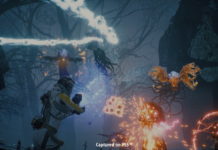“Gredia – a
land where humans, dragons and spirits live in relative harmony. When an evil
black dragon appears in the nation’s capital, Valen, a Dragoon, and the healer
Euphe must travel to Mt. Baird to seek answers from the Fire Dragon. But Valen
has yet to discover the tragic fate of the dragons…”
No console has
had more RPGs than PSone and PlayStation 2. It took a couple years for each
machine to get going, but once the floodgates were open, new RPGs continuously
poured through. Many presume that PlayStation 3 will follow suit, assuming Xbox
360 doesn’t steal its thunder beforehand.
In the handheld
market, Nintendo DS scored an advantage with the next Dragon Quest. But other
than that, the majority of handheld RPGs – most notably those from publishers
other than Square Enix – are being released for PlayStation Portable. NIS
America, one of the frontrunners of this market, is set to bring a port of the
original Disgaea to PSP this October. But that’s not the only game they’ve
developed. The publisher’s newest saga, Dragoneer’s Aria, is in stores now.

Combining Final
Fantasy-style combat and camera angles, Dragoneer’s Aria tells the story of a
young man named Valen who is trying to save the great protectors of the world –
the dragons. He’ll fight countless battles and have to withstand the forces of
the world’s most obnoxious monsters, all the while communicating with comrades,
upgrading his personal stats, and raising his party’s level to heights capable
of defeating whatever beasts come their way.

Looking The
Part
Starting things
off right with a well-voiced real-time intro, Dragoneer’s Aria is one of the
most broadly developed RPGs for the system. Battles flourish with large polygon
counts and a high magnitude of full-size environments. The puny, cartoony, and
sometimes super-deformed locales of other games are nowhere to be found, leaving
only the best architecture to see and explore. Stages are not limited to towns
and dungeons. They serve as the base points for most RPGs (this one included),
but this game goes off in its own direction.
Towns and
cities aside, going to a new location means having to fight new types of
monsters. You never know what creatures may be waiting in the next area, and how
much of a beating they’ll need to be defeated. Leveling up is an option most
players use to combat strong opponents. But this game doesn’t dummy-down the
experience by offering clear level-up points (with a save and health
replenishment spot right in the middle of a dungeon). You can pick a location
and pick off enemies until your HP has nearly emptied – the strategy I often use
– but without a guaranteed save spot, or the chance to save in a dangerous area
while broke and inexperienced, players could end up cornering themselves into a
deadly scenario.

Navigate thin and winding
platforms while fighting off enemy encounters,
which aren’t random but are typically hard to avoid.
Dragoneer’s
Aria has an excellent collection of music and voice-overs, bridging the gap
between handheld and console gaming experiences. The score is not one of massive
emotions – you won’t tear up at every tune. But it is extremely catchy,
frequently original, and forever entertaining. The antagonistic battle themes
are just a small sampling of what the game offers. Whether exploring a town,
visiting an inn, or viewing an ominous story sequence, the game is packed with
tunes that warrant a standalone listening session.
Combat is
purely turn-based; no real-time battle, active time battle, or any other kind of
turn-altering system has been employed. Your main points of action include
Attack, Mana, Guard, Item and Escape. The second one is special because it
doesn’t consume the hard-to-replenish MP of most RPGs. In this game, Mana is a
form of energy that’s gathered every time you perform a regular attack. Once a
certain amount has been acquired, any Mana abilities within your party will
become accessible.
Dragoneer’s
Aria is only partially successful in its effort to meet the quality of Final
Fantasy battles. They’re not excessively fast, which keeps the game from
transforming into a one-button process (an occurrence all too common these
days). But the motions are slower than the average PS2 RPG. If you were into the
genre during the PSone era, you’ll likely remember the mix of speeds that were
used in the abundance of games that followed FFVII’s release. In general, PSP is
closer to PSone than PS2. That being the case, Dragoneer’s Aria is not too far
off the mark.
But you will
still need patience of steel to get through certain parts of the game. In
addition to the slow battle progress, players will also have to deal with an
excessive number of load times. The pre- and post-battle loading isn’t too
awful, but you’ll sit for as long as six seconds per sequence when the
story is developing. That’s a fault with the PSP hardware and is nearly
impossible to avoid. Unfortunately, the presentation – which makes or breaks the
experience for some role-players – is obstructed by this issue.

Take on a vengeful boss before entering a coliseum-style hub
that can transport you to and from various locations.
On the up side,
it doesn’t kill the game. There is still a lot of good fun to be had with
Dragoneer’s Aria. The 3D graphics, behind-the-character view, and movable camera
are a definite plus. Those of you who play RPGs first for their stories may not
be fazed by the loading, even though it means you’ll have to wait a bit for each
sequence to appear. If that doesn’t sound like much of a problem, then wait no
further – there are dragons and Dragoons anticipating your arrival.
|
|
Gameplay: 7.0
The Mana system is
by far Dragoneer’s Aria’s best feature. Execute a few standard attacks, stock up
on Mana points, and unleash its power for a number of devastating attacks. Mana
can also be used outside of combat to enhance your character’s exploration
abilities. Other than that, the gameplay is the standard conglomerate of RPG
content – turn-based battles, frequent encounters, large worlds, etc.
Graphics:
8.2
Excellent worlds and
character art, pixelation-free backgrounds, impressive boss battles, and several
other graphic elements give Dragoneer’s Aria a striking visual boost. Few other
games on PSP – whether RPG or some other genre – can compare.
Sound: 8.0
Hokey moments aside,
the decent voice acting help to create a more believable storyline. However,
it’s the soundtrack that’ll form permanent memories.
Difficulty: Easy/Medium
Most challenges can
be overcome just by leveling up. But don’t get cocky – there are some battles
that will test your endurance, as well as your ability to flee the scene.
Concept: 7.0
Role-playing like
everything before it, Dragoneer’s Aria is a quaint homage to the Final
Fantasy series with original music and a good story.
Overall: 7.0
Not the freshest
game on the market, but if you want a slower-paced quest with an engaging story
and hours of battles to conquer, Dragoneer’s Aria is one of the better RPGs
you’ll find exclusively on PSP.









